 A picture of 2 fadnos. | |
| Woodwind instrument | |
|---|---|
| Classification | aerophone |
| Hornbostel–Sachs classification | 422.211.2 (single-reed aerophone with cylindrical bore and fingerholes) |
| Related instruments | |
| arghul, bülban, clarinet, diplica, dili tuiduk, dozaleh, cifte, launeddas, mijwiz, mock trumpet, pilili, Reclam de xeremies, sipsi, zammara, zummara | |
Fadno is a reed instrument and domestic flute of the Sami people of Scandinavia, made from Angelica archangelica. The instrument features a reed and three to six (generally four) fingerholes[1] and appears to have no parallels among the surrounding Scandinavian peoples.[2]
Characteristics
The instrument is made from a 15–30 cm length of the angelica plant (fadno, the term for one-year-old angelica), from which the instrument derives its name.[3] The instrument's reed categorized as an "idioglottic concussion reed",[4] meaning the reed is fashioned from the tube itself.[5] Fadnos were played with Sami drums together with joik.
References
- ↑ Etnografiska museet (Stockholm, Sweden); Statens etnografiska museum (Sweden) (1948). Ethnos. Routledge on behalf of the National Museum of Ethnography. p. 90.
- ↑ American Anthropological Association; Anthropological Society of Washington (Washington, D.C.); American Ethnological Society (1948). American anthropologist. American Anthropological Association. p. 673.
- ↑ Arthur Spencer (1978). The Lapps. Crane, Russak. ISBN 978-0-8448-1263-2. Retrieved 29 May 2011.
- ↑ Åke Hultkrantz. Swedish Research on the Religion and Folklore of the Lapps. The Journal of the Royal Anthropological Institute of Great Britain and Ireland Vol. 85, No. 1/2 (1955), pp. 81-99
- ↑ "Wind Instrument - The History of Western Wind Instruments". Encyclopædia Britannica. Retrieved 17 September 2016.
- Ernst Emsheimer (1947). A Lapp musical instrument (the fadno). doi:10.1080/00141844.1947.9980661.
This article is issued from Wikipedia. The text is licensed under Creative Commons - Attribution - Sharealike. Additional terms may apply for the media files.